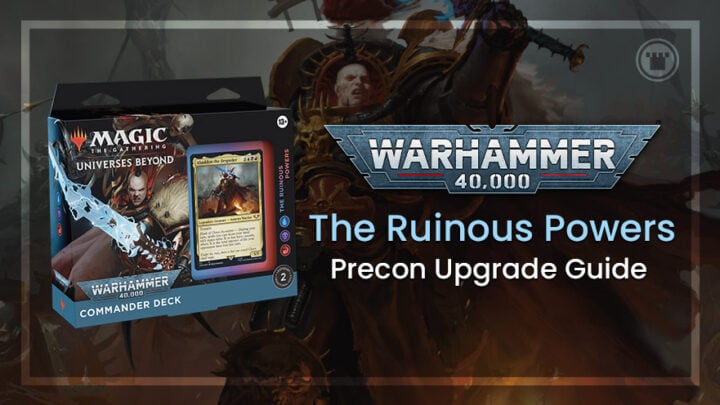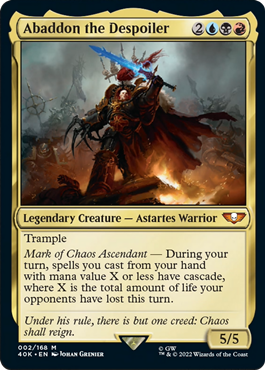It has been some time coming, but we finally know what Universes Beyond: Warhammer 40k will look like. It is perhaps the most ambitious Magic crossover project to date — four new preconstructed decks centered on one of the factions from the Warhammer 40k universe and full of many more new cards than usual. They’re all sure to pique the interest of both seasoned Magic players and Warhammer 40k players alike. But today, I’ll be walking through a deck upgrade guide for the The Ruinous Powers, which is based on the hordes of Chaos and the many horrors in their ranks.
New Commander Cards
These preconstructed decks are extremely unique, as they have many more new cards than any other precons before them. The Ruinous Powers has a whopping 42 new cards, which is usually the total you’d see across an entire new set of decks.
That also means there are far too many to dive into detail with each one, but I’ll offer a breakdown of the most important new cards from this deck:
Abaddon the Despoiler is the face commander for The Ruinous Powers, and he’s a formidable combatant. His base stats are decent, and his Mark of Chaos Ascendant ability gives spells cascade, depending on how much life your opponents lose on your turn.
There are several cascade themed commanders in Magic, but this is the first dedicated one in this exact color combination, making him likely to become one of the most popular commanders from this set.
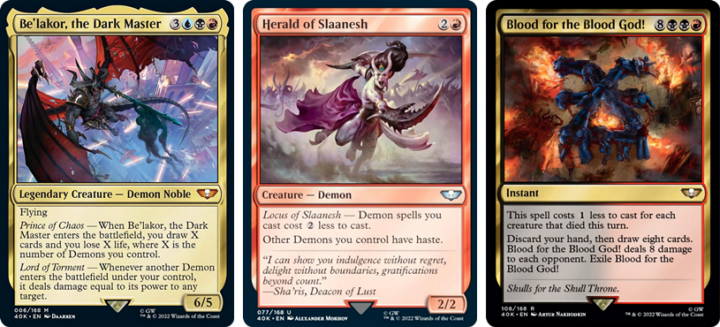
Be’lakor, the Dark Master is the secondary commander for the deck and is more heavily focused on demons than playing from exile. Their abilities are extremely potent. Between drawing cards for having demons in play and acting as a demon-specific Warstorm Surge, they’re well suited to lead a demons matter deck.
If you’re looking to lean into the demon subtheme, then Herald of Slaanesh is the card for you. Like their angelic counterparts, demons tend to be on the higher end of the curve. Giving them all a two mana cost reduction can really help get on board quickly.
Blood for the Blood God! is a strange yet powerful new wheel effect. It’s the perfect card to play following a board wipe, as it’ll likely cost just three mana to give you a new hand and knock an enormous chunk off your opponents’ life totals. This could see a lot of play, so be careful when you try to destroy all of the Rakdos player’s board going forward!
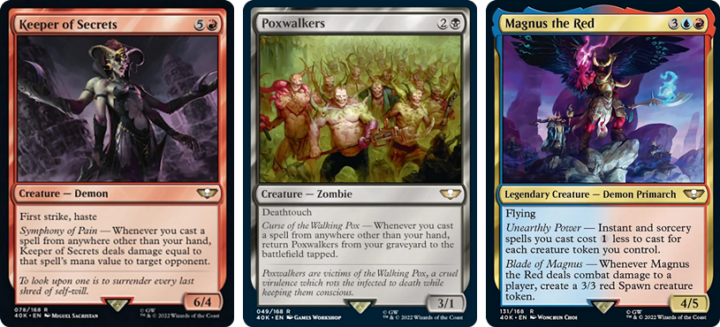
There are a number of exile matters cards in this deck, and Keeper of Secrets is one of the best. It’s a big beater in its own right, but the damage from its Symphony of Pain ability can add up very quickly in cascade or exile-based decks.
Poxwalkers, meanwhile, might seem innocuous at first, but free recursion abilities are often very abusable. Given how many ways there are now to play spells from anywhere other than your hand, this could show up in a lot of decks — even if only as a repeatable Skullclamp victim.
Next, Magnus the Red mixes the cost reduction and token making aspects of spellslinger decks into one legendary creature. Izzet isn’t a color pairing that’s short on either of these abilities, but having both in the command zone will entice many players to build around them.
The Ruinous Powers Deck Review
The Ruinous Powers features a few different themes: cascade, playing from exile, demons and dealing damage. They have varying levels of support within the ninety-nine, and it all comes together to form a fairly solid package.
Most of the themes interlock to create a sort of chain-like effect. Many cards in the deck deal damage, Abaddon the Despoiler rewards you for dealing damage by giving your spells cascade and a lot of your spells either have cascade already or reward you for playing from exile.
Like many other cascade-based decks, The Ruinous Powers wants to generate an absurd mana advantage to go over the top of your opponents. It’s more aggressive leaning than the likes of Prosper, Tome-Bound, largely thanks to Abaddon’s ability needing direct damage to be dealt to opponents.
The curve is quite high, however — 4.31 is much higher than most, with the bigger demons contributing more than their fair share to the high average mana cost. It can feel a little clunky when you don’t curve out smoothly, but the high land count helps to reduce the chances of this happening.
While two thirds of the nonland cards are brand new, there are still some solid staples in the ninety-nine. Chaos Warp, Reverberate and Blasphemous Act are welcome additions to any red deck, and the suite of mana rocks here is fairly impressive. Chromatic Lantern, all three on-color Talismans and Sol Ring all see a lot of play and are worth a few dollars each. Chromatic Lantern in particular is a fantastic reprint, as it’s currently around $13 at the time of writing.
The monetary value of the whole of The Ruinous Powers is difficult to gauge right now. There are more new cards than we’re used to seeing in a preconstructed deck, so it’s hard to tell where their prices may settle. As it stands now, the value of the individual cards comes in at more than $130. Considering the price of the deck is $59.99 at the time of writing, it’s likely to be money well spent at the very least.
Even in the unlikely event that the deck’s value drops over time, it’s still a great product. The Ruinous Powers should play very well out of the box. It’s a solid precon with a lot of potential, and it has a very on-theme feel for the franchise. Playing with this deck will feel fresh and interesting, and I’d even consider keeping the deck intact for the full Warhammer 40k experience. Its power level is roughly on par with some of the more recent offerings, particularly the Dungeons & Dragons: Adventures in the Forgotten Realms precons.
Upgrading The Ruinous Powers
If you want to upgrade the deck, there are a couple of approaches you can take. If you like the demon subtheme, you can replace Abaddon with Be’lakor, the Dark Master as the commander — though it may require a bit more work than simply swapping out a few cards.
The simplest and most effective way to upgrade the deck is to lean into the cascade and exile aspects and replace the clunky, off-theme cards with more streamlined and focused choices.
The main focal points for this upgrade will be:
- Improved Exile
- Dealing Damage
- High Impact Value
Anything that doesn’t compliment either the main game plan or bolster any of the pillars of the upgrade will be replaced by something better suited.
Improving Exile
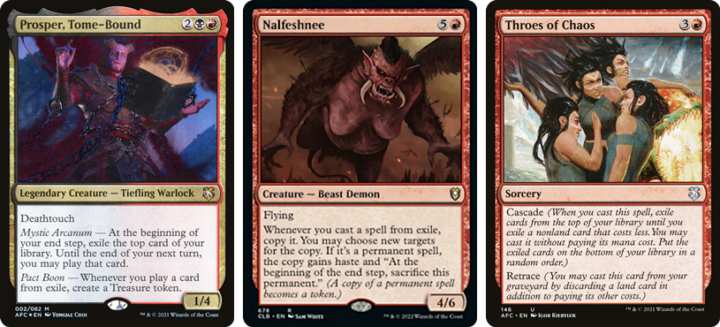
Abaddon the Despoiler grants cascade to spells, so maximizing the benefit from this is the first port of call. Prosper, Tome-Bound is (in)famous for being an incredible exile matters commander, so it’s no surprise his treasure rebate ability and impulse draw abilities will fit right in here.
What’s better than playing free spells from exile? Copying them! Nalfeshnee might cost six mana to cast, but they’re the kind of card that will snowball out of control when you start casting spells from exile. If your opponents don’t answer this immediately, you’ll start doubling the advantage from your cascade spells. They’re also a demon, which is still relevant in the upgrade.
As I mentioned earlier, the land count is a bit high (38 lands). It’s slightly more possible to flood out in a deck like this, which is why Throes of Chaos is so powerful here. Every top-decked land now becomes a four mana cascade trigger. Even if you’re low on things to do, you can still play spells from exile and keep your value train powering forward.
Dealing Damage
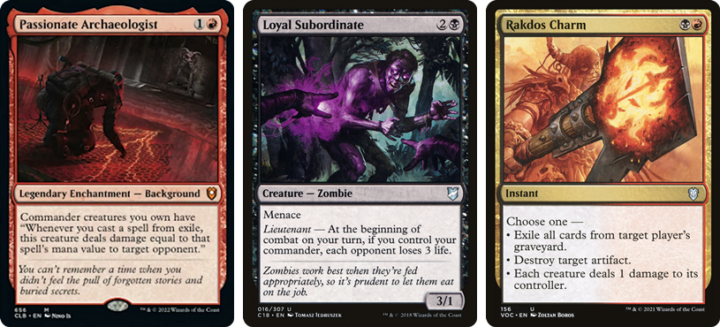
Adding damage dealing spells benefits you in two ways: it’s easier to enable Abaddon’s cascade ability and they meaningfully move the game forward. The more damage you deal, the better.
Passionate Archaeologist is a second copy of Keeper of Secrets, only it’s much cheaper to cast and requires Abaddon to be on board to work. That’s a very easy requirement to meet, and it will help to take your opponents down in no time.
Loyal Subordinate is an excellent repeatable source of noncombat damage, which can be crucial against opponents that have Ghostly Prison effects on board. Every time Subordinate deals its full damage to opponents, that covers spells up to a mana value of nine with Abaddon’s ability! It’s one of the most reliable ways you can continually cascade with him, and it’s arguably the best card in the upgrade.
The Ruinous Powers isn’t short of removal, but Rakdos Charm deserves a spot regardless. Its graveyard exile and artifact removal modes are great as usual, but its damage ability can immediately turn on Abaddon’s cascade effect. It’s incredibly flexible, and this is one of the best homes for this staple.
High Impact Value
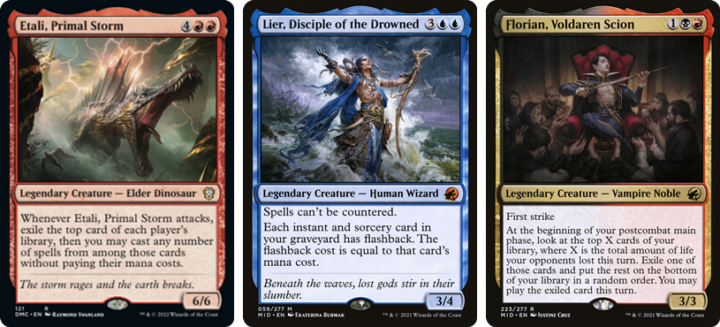
Abaddon and cascade spells may give you a lot of power and advantage, but the individual card quality can be a bit lower than their non-cascade counterparts. This is why it’s important to include some heavyweight value engines that can improve your overall card quality.
Etali, Primal Storm is the perfect example. They can get you up to four free spells when they attack. This is usually good enough by itself, but your exile matters cards will supercharge them and give you even more advantage from them!
Lier, Disciple of the Drowned lets you replay spells like Bituminous Blast and Deny Reality from your graveyard, giving you twice the value from each instant and sorcery as well as another cascade trigger. He’s also a decent spell to cascade into, and makes all spells uncounterable just in case there’s a counterspell-heavy deck at the table.
Since you’re dealing a lot of damage to opponents for Abaddon’s cascade ability, you may as well add Florian, Voldaren Scion to truly take advantage of every point of damage. It’s easy to deal a total of more than 20 damage per turn in this deck, and Florian translates that into the best impulse draw effect in the deck.
Additional Upgrades
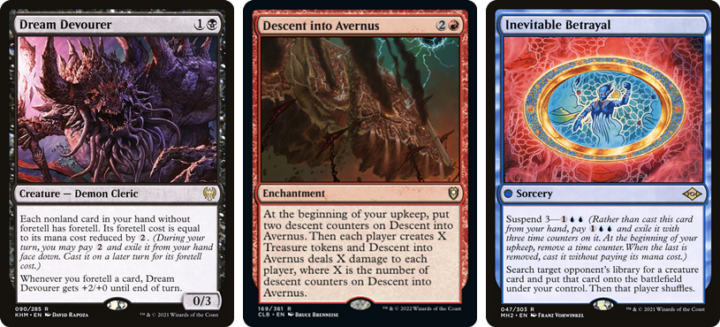
There are a few additional upgrades that don’t quite fit in the other categories but are still worth mentioning. Dream Devourer is a great little demon that can foretell cards so you can cast them from exile later. It also lets you invest excess mana in spells for a later turn, which can really help smooth out the clunky curve even more.
Descent into Avernus may accelerate each player with treasures, but it also deals increasingly more damage to them with every turn. You will benefit the most from this. You’ll get to your bigger spells quickly, and the damage will increase the range of spells that are affected by Abaddon’s ability. And since you’re likely the most damaging deck at most tables, the symmetrical damage will also feel much more one-sided.
Finally, as this is a cascade deck, adding some cards with suspend is a great way to improve the quality of the cards you play for free. Inevitable Betrayal, Profane Tutor and Ancestral Vision can be hit with any card’s cascade ability, and they will give you a huge advantage when cast.
The Full Upgrade
The final list is much more focused, and the average mana cost is reduced to a much more manageable 3.81. The demon subtheme is a little less prominent than before, but it’s still there — and Be’lakor, the Dark Master will continue to provide you with decent value and reach.
The total cost of this upgrade is roughly $50. This is the sweet spot in Commander to me: the power-to-dollar ratio is at its highest around this price point and it can be easily tweaked to increase or decrease in power as you see fit. If you like this deck, you can buy all the upgrade singles at the same time as the preconstructed deck, saving you time as well as money.
Whether you buy the full upgrade, just the preconstructed deck or some unique upgrades of your own, be sure to show off your awesome new cards to us on Twitter!

Scott is an Irish content creator and the Head of Budget Magic for the Izzet League. He focuses on affordable decks in Pioneer, Modern, and Pauper, particularly ones that stray from the mainstream. When he’s not writing about his favorite decks, he can be found talking incessantly about them on Twitter and on The Budget Magic Cast.

